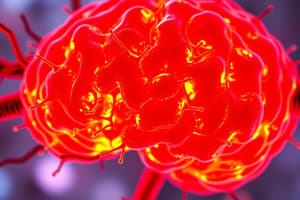Podcast
Questions and Answers
What is the primary effect of an excitatory postsynaptic potential (EPSP)?
What is the primary effect of an excitatory postsynaptic potential (EPSP)?
- It prevents the entry of ions into the postsynaptic cell
- It causes the postsynaptic membrane to become more negative
- It causes the postsynaptic membrane to become more positive (correct)
- It inhibits the generation of an action potential
Which of the following ions contribute to the generation of an EPSP?
Which of the following ions contribute to the generation of an EPSP?
- Sodium and calcium ions (correct)
- Sodium and potassium ions
- Potassium and chloride ions
- Chloride and calcium ions
Which neurotransmitter is typically associated with the generation of EPSPs?
Which neurotransmitter is typically associated with the generation of EPSPs?
- GABA
- Acetylcholine
- Glutamate (correct)
- Dopamine
Where are the ion channels responsible for EPSPs located on the postsynaptic neuron?
Where are the ion channels responsible for EPSPs located on the postsynaptic neuron?
What is the primary function of EPSPs in neural communication?
What is the primary function of EPSPs in neural communication?
How do EPSPs modulate signaling within the postsynaptic neuron?
How do EPSPs modulate signaling within the postsynaptic neuron?
What is the main neurotransmitter associated with excitatory postsynaptic potentials?
What is the main neurotransmitter associated with excitatory postsynaptic potentials?
Which ion flows into the postsynaptic cell during the activation of inhibitory neurotransmitter receptors like GABA-A receptors?
Which ion flows into the postsynaptic cell during the activation of inhibitory neurotransmitter receptors like GABA-A receptors?
How quickly can glutamatergic synapses typically generate EPSPs?
How quickly can glutamatergic synapses typically generate EPSPs?
What happens to the membrane potential of a postsynaptic cell during the activation of inhibitory neurotransmitter receptors?
What happens to the membrane potential of a postsynaptic cell during the activation of inhibitory neurotransmitter receptors?
Which disorder may result from excessive excitation in neural signaling?
Which disorder may result from excessive excitation in neural signaling?
What is the most common inhibitory neurotransmitter in the mammalian central nervous system?
What is the most common inhibitory neurotransmitter in the mammalian central nervous system?
Flashcards are hidden until you start studying
Study Notes
Postsynaptic Inhibition: Excitatory and Inhibitory Potentials
Postsynaptic inhibition is a crucial aspect of neural communication. It involves the activation of specific receptors on the post-synaptic neuron which results in reduced activity. This type of inhibition operates alongside excitatory signals generated by neurotransmitters released via synapses. Understanding this process helps us grasp the complexities of signal transmission between neurons and how it contributes to various physiological functions.
Excitatory Postsynaptic Potentials (EPSP)
An Excitatory Postsynaptic Potential (EPSP) occurs when the postsynaptic membrane becomes more positive due to the entry of positively charged ions such as sodium ions or calcium ions into the cell interior. These ions enter through ion channels and create an electric field across the plasma membrane that can depolarize the membrane, making it closer to its threshold for firing an action potential. Depending on the strength of the EPSP, it may contribute to generating an action potential in the postsynaptic cell or modulate other forms of signaling within the neuron.
The release of excitatory neurotransmitter molecules like glutamate from presynaptic cells leads to the opening of ligand-gated ion channels located on the dendritic spines of the target neuron, allowing these ions to flow in and cause the EPSP. Glutamatergic synapses typically exhibit rapid kinetics, meaning they can generate robust EPSPs within milliseconds after stimulation.
Inhibitory Postsynaptic Potentials (IPSP)
In contrast, an Inhibitory Postsynaptic Potential (IPSP) is produced by the activation of inhibitory neurotransmitter receptors, such as GABA-A receptors, which are coupled to chloride ion channels. When these receptors are activated, chloride ions flow into the postsynaptic cell, making it more negative and pushing the membrane potential further away from the threshold for firing an action potential.
The inhibitory neurotransmitter, γ-aminobutyric acid (GABA), is the most common inhibitory neurotransmitter in the mammalian central nervous system. GABAergic synapses are typically slower than glutamatergic synapses, with their IPSPs taking seconds to develop fully and lasting for several seconds after the release of GABA.
The balance between excitatory and inhibitory signals is crucial for proper neural function. An excess of either type of signal can disrupt normal functioning, leading to neurological disorders. For example, excessive excitation may result in epilepsy, while excessive inhibition may cause movement disorders like Parkinson's disease. Understanding the mechanisms of excitatory and inhibitory postsynaptic potentials is essential for developing potential treatments for these conditions.
Studying That Suits You
Use AI to generate personalized quizzes and flashcards to suit your learning preferences.



